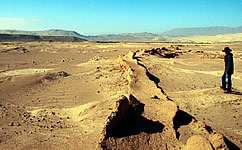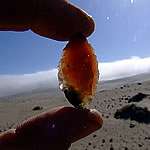An ancient Nasca canal in the desertified modern landscape of the lower Ica Valley, south Peru.
A study of food remains from ancient settlement sites along the lower Ica valley in Peru, confirms earlier suggestions that farming undermined the natural vegetation so badly that eventually much of the area had to be abandoned.
A research ream led by the University of Cambridge looked for evidence of wild and domesticated foods from settlement sites spanning roughly 750 BC to 1000 AD. They found that, in less than two thousand years, the valley inhabitants had gone from subsisting on gathered foods, through a period of intense agriculture, and back again to a largely subsistence diet.
This confirms earlier evidence suggesting that, by removing too much of the natural vegetation to make way for crops, the farmers exposed the land to flooding and erosion that eventually made it impossible for them to farm at all.
"The farmers inadvertently crossed an ecological threshold and the changes became irreversible," says Dr. David Beresford-Jones of the University of Cambridge.
Obsidian point from land snail shell midden in Lomas de Ullujaya, of precisely the dimensions to extract flesh.
Though the area looks barren today, the remains of native huarango trees, and patches of buried soils, show that this wasn't always the case. Previous work by the research team, including landscape surveys and pollen analysis, had revealed what looked like a sequence of increasingly sophisticated agricultural development, landscape clearance and abandonment.
In this new study, published in Vegetation History and Archaeobotany, the researchers took samples from the rubbish, or midden, mounds of ancient settlements along the lower Ica valley, dating from between around 750 BC to AD 900.
They used water to wash away the sediment from the samples, in a process called flotation, to leave behind a mixture of plant and animal remains that shed light on the changing diet of the valley's inhabitants.
The samples from the earliest dates had no evidence of domesticated food crops. Instead people lived on snails, together with sea urchins and mussels gathered from the Pacific coast, an eight-hour journey to the west.
By the last century BC, finds of pumpkin seeds, manioc tubers and maize cobs suggest that people were now growing a significant proportion of their food, and a few hundred years later there is evidence for much more intensive agriculture, with a wide range of crops including maize, beans, pumpkins, peanuts and chillis.
But 500 years on, things seem to have turned full circle. The middens are once again full of marine and land-snail remains, together with wild plants but no domesticated crops.
Farming wouldn't have been possible without the natural huarango woodland, which literally held the floodplain together, physically anchoring the soils and protecting the ground from erosion, and maintaining fertility by fixing nitrogen and moisture into the soil.
But as more land was need for crop production, it looks like so much of the woodland was cleared that this balance was upset irretrievably. The cleared ground would have been exposed to El Niño flooding, erosion from which irrigation canals were left high and dry, and then to one of the world's strongest wind regimes.
The pattern seems to be confirmed by indirect evidence for human practices – known as proxy evidence. For example, in the more recent samples the researchers found weeds that like to grow in disturbed ground, which can be a sign of farming even when crops themselves aren't present. Similarly, more recent samples contained more grass remains, indicating that the landscape was becoming more open, rather than wooded.
A good example of such proxy evidence is the Indigofera shrub, parts of which provide an intense blue dye. Indigofera seeds are common finds at Early Nasca sites, dating to between 100 and 400AD. Textiles from this period are easily recognizable by their lavish use of this distinctive color. But the researchers found no evidence for the plant in later periods – a scarcity reflected in the increasingly rare use of the dye itself. Indigofera thrives in the shade along water courses so its decline suggests that the woodland was disappearing. Today it does not grow at all in the lower Ica Valley.
"By itself this evidence of the human ecology gives us snapshots of what was happening at different places and times across the valley settlements," explains Beresford-Jones. "But read together with other evidence it supports our earlier conclusions about the pattern of human-induced landscape change here."
This story is republished courtesy of Planet Earth online, a free, companion website to the award-winning magazine Planet Earth published and funded by the Natural Environment Research Council (NERC).
More information: David G Beresford-Jones, et al. 'Two millennia of changes in human ecology: archaeobotanical and invertebrate records from the lower Ica valley, south coast Peru'. Veget Hist Archaeobot 2010, 20:273-292. doi:10.1007/s00334-011-0292-4
Provided by PlanetEarth Online























